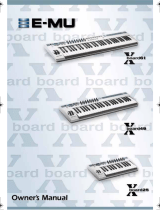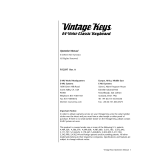Page is loading ...

REMIX
REVIEWS
TECH SECTOR
>
When I think back to my first studio—where I was surrounded by an ominous wall of keyboards, sound
modules and flashing lights—I can’t help but pat myself on the back for deciding to streamline my setup.
The days of walking into my studio and feeling like I’m starting up a launch sequence for a UFO are a thing
of the past. Instead of navigating a sea of cables, I have simplified my home-studio setup to comprise only
the bare necessities: my computer, a solid audio interface and Apple Logic Pro 7. So what was missing? A
MIDI controller.
I have been using MIDI controllers in my professional studio and to teach Logic at SAE Institute for quite
some time now. Although I like the controllers that I’ve been using, I keep a close eye on what’s new in the
market, but nothing has really impressed me. So when I heard about E-mu’s new Xboard line of MIDI control-
lers, I was intrigued and curious. But the first question I must ask is what makes these different?
The most obvious difference is that the Xboard line ships with Ableton Live Lite 4, the E-mu Proteus X LE
desktop sound module and the Xboard Control software. This package not only gets you up and running
right away with a great program like Live but also gives you a sound module. For anyone who is a novice at
computer-based music, this package would be ideal to get you started. I must note that the Proteus X LE
software is currently only available for PC users, but, luckily, the control and editing software works on both
Mac and PC.
SOMETHING NEW
First, take a minute to get into some of the physical differences between the Xboards and the other controllers
on the market. The E-mu units have 16 rotary-style knobs and one slider. For those who like knobs to tweak,
this is great news; for all of the others who like sliders, you’re out of luck on this one. The main advantages with
Pros: Elegant, well-designed MIDI control-
lers. Full-size keys with aftertouch. Included
software is a great value.
Cons: Using advanced MIDI functions can
be cumbersome.
Contact: www.emu.com
Mac: Mac OS 10.2 or later; native USB port
PC: Windows 2000 SP4/XP SP1 or later;
native USB port
MADE TO PLAY > The E-mu
Xboard 25 and 49 (pictured)
each feature 16 MIDI-assignable,
rotary-style knobs and one slider.
Each unit also has the ability to
save a max of 16 presets.
CLASSIC FEEL > Both of the
Xboards feature full-size keys
and E-mu’s synth-action keybed,
which includes true aftertouch.

REMIX
REVIEW >
knobs rather than sliders are space and cost. You get
more space, and the price remains on par with other
entry-level MIDI controllers. The next feature that
stands out on the Xboards is aftertouch. If you are a
fan of this fine MIDI function, you will be glad to know
that the Xboards are some of few MIDI controllers that
come with true aftertouch. The nonweighted, full-size
keys have great response and feature E-mu’s synth-
action keybed. To activate aftertouch, just press the
keys down easily—unlike other aftertouch functions,
which feel like you about need to break your keys
to make them work. The aftertouch has a sensitive
response and feels totally natural. What’s more, it can
be turned on and off in the edit menu.
Some of the more unique features of the Xboards
include a 16-channel control mode that allows the
16 knobs to send one CC number each. This allows
you to control the volume or pan of 16 different
MIDI devices on 16 separate MIDI channels. The
Xboards also have the ability to send MIDI CC and
program-change data when recalling a patch. This
function is great for linking a soft-synth patch to one
of the Xboard’s 16 patches. That way, if you have a
virtual synth open and you recall a preset patch on
your Xboard, it will load a preset patch on your synth
when it recalls the patch from the Xboard. You can
store a max of 16 presets in the Xboard’s internal
memory. And with the included software editor, it’s
possible to save and access presets with your host
computer—the sky’s the limit.
TWO OF A KIND
The Xboard comes in two sizes: 49 keys and 25
keys. And the only difference between the two ver-
sions is the number of keys. Both have a MIDI Out
port, a USB connection, an on/off switch and a 6V
DC power jack located on the back. Both also have
standard mod and pitch wheels.
All of the back-panel connections are rather stan-
dard, but what did grab my attention was the bat-
tery compartment located underneath the control-
ler. Yes, that’s right: The Xboards can run on just
three AA batteries. Whenever I come across a device
that runs on batteries, my interest is piqued. There’s
something appealing about being able to create
music in any setting, and gear that runs on batter-
ies is just begging to be used anywhere there’s an
audience and anytime you find inspiration. A cool
thing to note about the battery compartment is that
it provides you with three extra spaces to store a full
set of backup batteries.
TEST RUN
After reading the manual and realizing all of the
cool new things I could do with this MIDI controller,
I was anxious to put it to the test. I first installed
the software on two computers: an Apple Mac G4/
dual 533MHz, running Mac OS 10.3.8, with 1 GB of
RAM and a Pentium III/1.6GHz Dell Latitude D 600
PC, running Windows XP, with 512 MB of RAM. The
sequencing programs I used were Logic Pro 7 for
the Mac and Live Lite (included with both Xboards)
for the PC.
In both of the test situations, neither computer
was loaded to the gills, but I wanted to make sure
that both of the Xboards would function as easily
and reliably for users with less memory and slower
processors. In addition to the computer sequencer
test, I also used a Boss DR-660 drum machine to
see how well the Xboards could control it in a live
setup (more on this later). Installing the software on
both computers was a snap. I simply followed the
install instructions from the manual and finished in
about 10 minutes. The next step was to see if my
sequencing programs recognized the Xboards. In
both cases, Logic and Live were able to recognize
the Xboards via the USB connection.
Now that the software was installed and the con-
troller was working, I wanted to check out the editing
software that is also included. I went to the Xboard
application and ran it to see how the systems would
support running the two applications at the same
time. I’m glad to say that both machines chugged
along happily; I was able to run the Xboard editor
and the sequencing application at the same time
without any major issues. Anytime two programs
are trying to access the same piece of hardware, like
a MIDI controller, there are expected bugs to work
around, but, overall, I found it easy to use the editing
software and sequencing software simultaneously.
The editing software provides you with an intuitive
interface that makes changing MIDI CC numbers a
snap. The control and editing software also allows
users to store and recall patches directly from their
computers’ hard drives. So as you can see, by using
the editing software, you are able to store well over
16 patches to your computer.
LIVE USE
If you need a MIDI controller for live performances,
you might want to think about these next features.
Each Xboard has a mode called Knob Bypass that
allows you to move any of the 16 CC knobs without
sending control data to your sequencing program
or MIDI device. This Knob Bypass mode by itself is
not all that cool, but when you put it together with
the Snapshot feature, it proves to be quite powerful.
When pressed, the Snapshot button will send the
current values for all 16 knobs in one shot. So you
can bypass the knobs, change the values and then
unbypass the knobs and press Snapshot to send
all of the new values to the device without missing
a beat. To further test how an Xboard can be use-
ful in a live setup, I tested the 16-channel control
mode with the DR-660 drum machine. Once again,
I encountered no issues to mention.
Although it was painless to get the Xboards up
and running as basic MIDI controllers, if you want
to use more of the advanced features, I recom-
mend ordering takeout and making a night of it.
Getting an Xboard to send out the CC numbers on
program recall will take some time depending on
what sequencing program you’re using and what
soft synth you have loaded. For instance, if you want
to send a program change message to a soft synth,
it has to be able to change programs via a program
change message. I found the Native Instruments
Pro-53 works well for this. But rest assured, if you
have any problems, you’re not on your own. The nice
people at E-mu provide you with a number to a live
technical-support representative. I decided to give
tech support a call, and I am happy to report that I
had no hold time and found the representatives to
be not only helpful but also very friendly.
Overall, the Xboards are solid MIDI controllers that
include some useful software—a trend that I hope
will continue. It would be great if manufacturers
started shipping MIDI controllers with full-version
soft synths instead of demos and LE versions. The
advanced MIDI control features on the Xboards
are exciting and provide some insight into what to
expect from future MIDI controllers. Furthermore,
both units were a pleasure to use and actually play.
It almost goes without saying, but there’s just some-
thing about using a keyboard controller that feels
and plays like a real instrument.
GOIN’ PLACES > The Xboard 25 utilizes a two-octave
keyboard but is otherwise functionally identical to
the larger Xboard 49.
/









